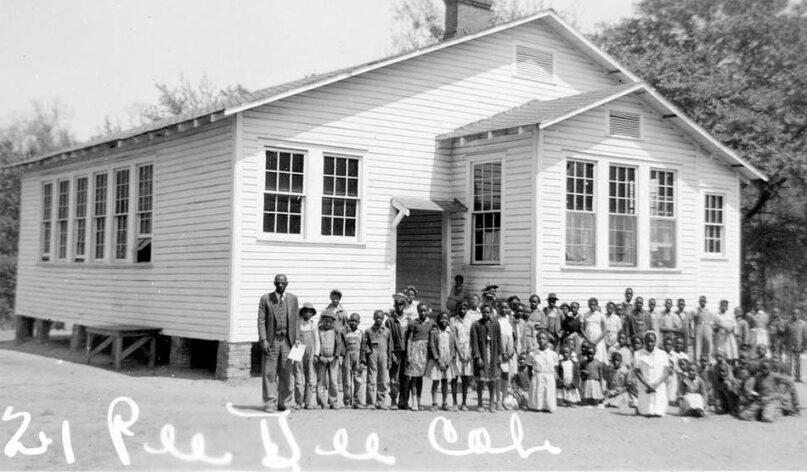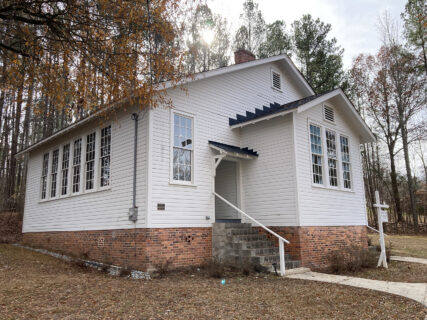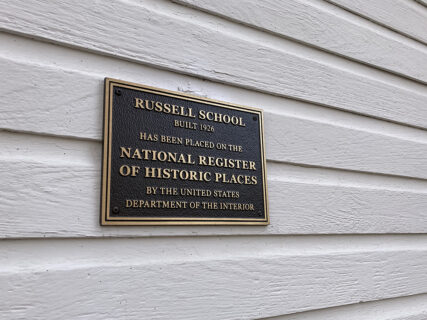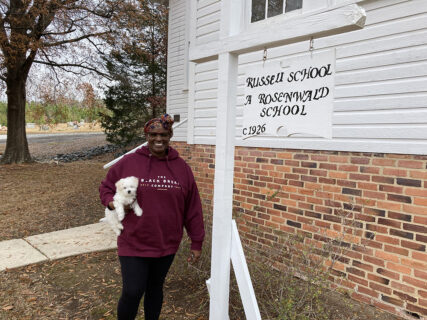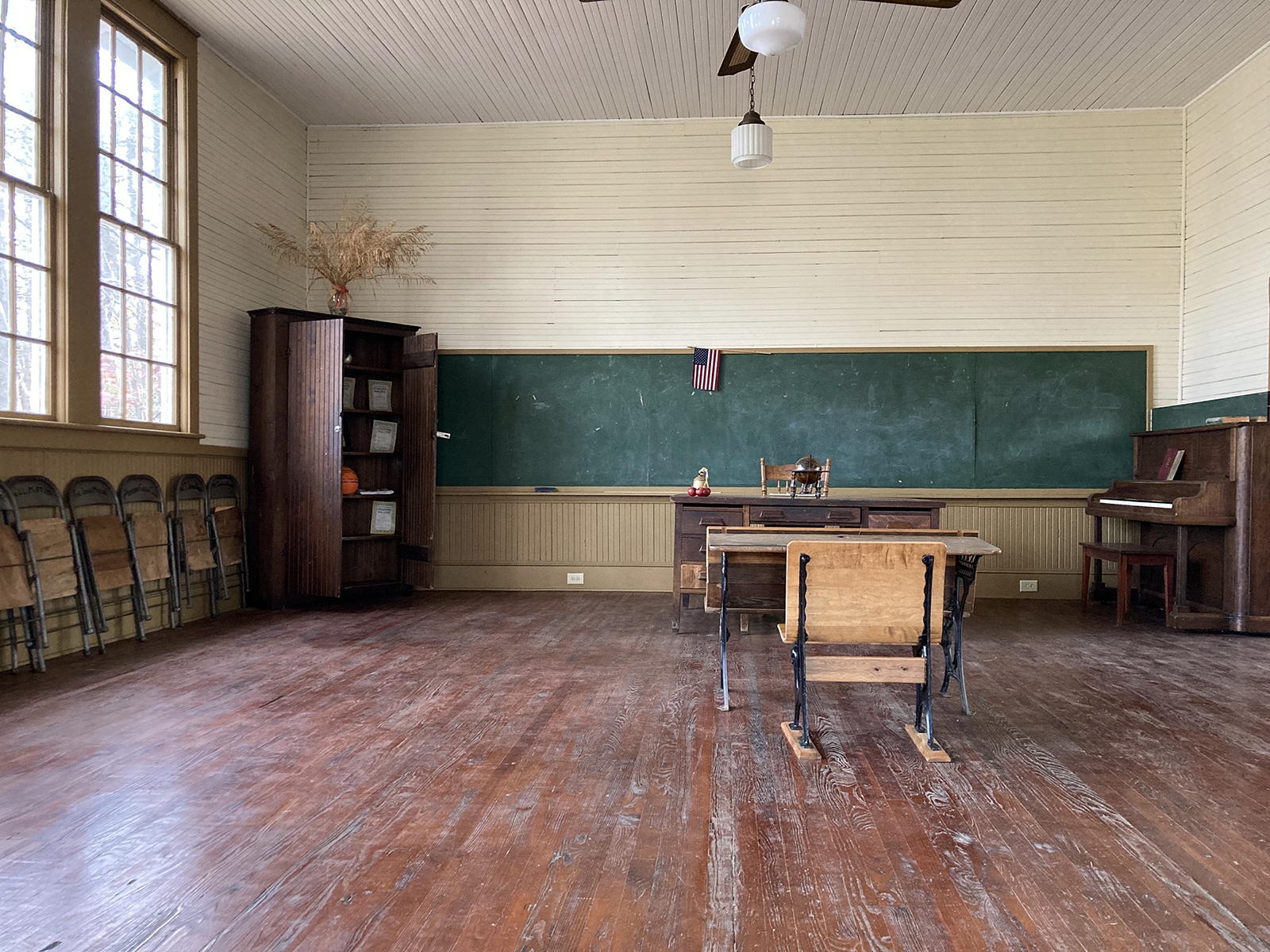
The Russell School has been lovingly preserved and includes an original desk and chalkboard. The school was one of 17 Rosenwald Schools in Durham County, and 787 across North Carolina, that served Black children. Schools like this one were constructed in 15 states between 1912 and 1932 with funding by Sears executive Julius Rosenwald. RNS photo by Yonat Shimron
DURHAM, N.C. (RNS) — A chill hung in the air inside the Russell School on a recent blustery December afternoon.
The old schoolhouse has no indoor heat and is usually closed in the winter. When it first opened in 1926, it had no electricity or bathrooms, either.
But with daylight streaming in from a series of tall windows, hundreds of Black schoolchildren learned to read and write here. This school was one of nearly 800 across North Carolina called Rosenwald Schools after their chief benefactor, Julius Rosenwald.
Soon, the Russell School, lovingly preserved by the church next door, may become one of half a dozen sites in a proposed Julius Rosenwald & Rosenwald Schools National Historical Park.
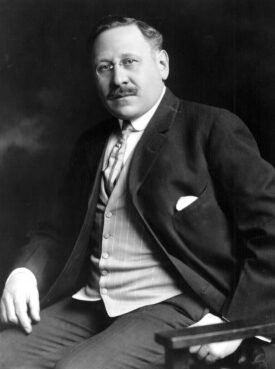
Julius Rosenwald in 1922. Photo courtesy of Wikipedia/Creative Commons
If approved by Congress, a select group of Rosenwald Schools would join 424 other units that make up the National Park Service — best known for such parks as Yosemite and Yellowstone, as well as monuments such as the Statue of Liberty and the Jefferson Memorial.
Also envisioned for the “discontiguous” park project — so named because the sites are in various locations across several states — is a visitor center in Chicago, where in 1908 Rosenwald became president of the world’s largest retailer, Sears, Roebuck and Co. Amassing enormous wealth, he partnered with Black educator and civic leader Booker T. Washington to fund the construction of more than 5,000 rural schools and school-related buildings across 15 Southern states.
While the interior of some of the schools may be cold, there’s a lot of warmth around creating the park, the first of its kind to honor a Jewish American and to honor his philanthropic efforts.
“There’s a big gap in the National Park system in telling the story of America,” said Dorothy Canter, president of the campaign for a Rosenwald Historic Park and a 30-year volunteer for the National Parks Conservation Association. “This will tell the story of a Jewish American.”
In 2015, Canter went to a movie theater in Maryland to see a documentary by Aviva Kempner called “Rosenwald,” chronicling the Chicago businessman’s philanthropy toward Blacks living in the segregated South whose educational opportunities were grievously unequal. By the time it was over, she turned to her husband and said, “There needs to be a national park for Julius Rosenwald and the Rosenwald Schools.”
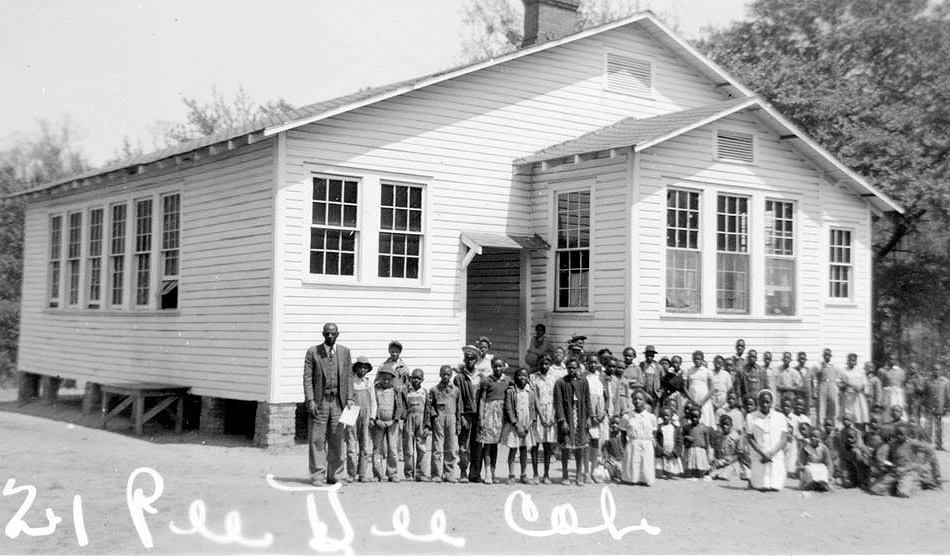
People pose outside the Pee Dee Rosenwald School in Marion County, South Carolina, c. 1935. The Pee Dee Rosenwald School was built in 1922-1923 with two classrooms and two cloakrooms. A chalkboard was located on the partition between the two rooms. Students’ desks faced the chalkboard, with the teachers’ desks off to the side. The wall between the classrooms could be moved to open a large space in the school. Photo from the South Carolina Department of Archives and History/Creative Commons
Rosenwald, who was born in 1862 to German Jewish immigrants and later became co-owner with Richard Sears of the mail-order company, the country’s largest at the time, was in danger of being forgotten.
An early and enthusiastic philanthropist, Rosenwald shunned the trappings of wealth and did not believe in perpetual endowments. The Rosenwald Fund, which he created to pay for the construction of schools, was designed to go out of business 25 years after his death.
Rosenwald’s legacy is, however, better known in the South.
“If you’re in an African American community and say ‘Rosenwald Schools,’ the older generation will certainly know of them,” said Valinda Littlefield, associate professor of history at the University of South Carolina who studies Southern Black education. “If you say ‘Rosenwald Schools’ to a majority white population, that knowledge isn’t going to be there.”
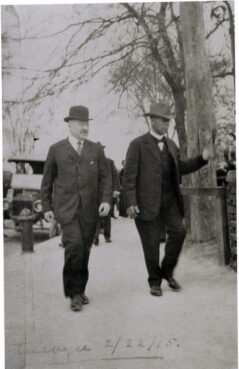
Julius Rosenwald, left, and Booker T. Washington on the campus of Tuskegee Institute in 1915. Photo courtesy of Stephanie Deutsch
The historic park is intended to correct that.
Rosenwald was 49 when he met Washington, then principal of Alabama’s Tuskegee Institute, now a university. Rosenwald had read Washington’s autobiography, “Up From Slavery,” and it had made an impression. The two met in a Chicago restaurant and Washington invited Rosenwald to travel to Tuskegee to see his school. There the two came up with the idea of building schools for Black children through a system of matching grants. Rosenwald would contribute cash (typically $300 per school, sometimes more). The Black community contributed an equal amount in cash, labor, materials, land or a combination thereof. Local and state governments also contributed about a third of the cost.
“The two men hit it off,” said Stephanie Deutsch, author of a book about Rosenwald and Washington. “They were from two separate backgrounds. But they were both very practical. They were doers and results oriented.”
The first Rosenwald School was built in Alabama in 1912. By the time of Rosenwald’s death in 1932, a total of 5,357 schools, teacher homes and shop buildings dotted the South.
Bessie Whitted Pearley attended the Russell School in Durham County (named for Thomas Russell who donated the land) beginning at age 5. Now 89, she’s proud of the work her church, Cain’s Chapel Missionary Baptist, has done to preserve the old schoolhouse.
“I would like children to know where we come from and how our people accomplished things and what you could do if you have your mind set on it,” she said.
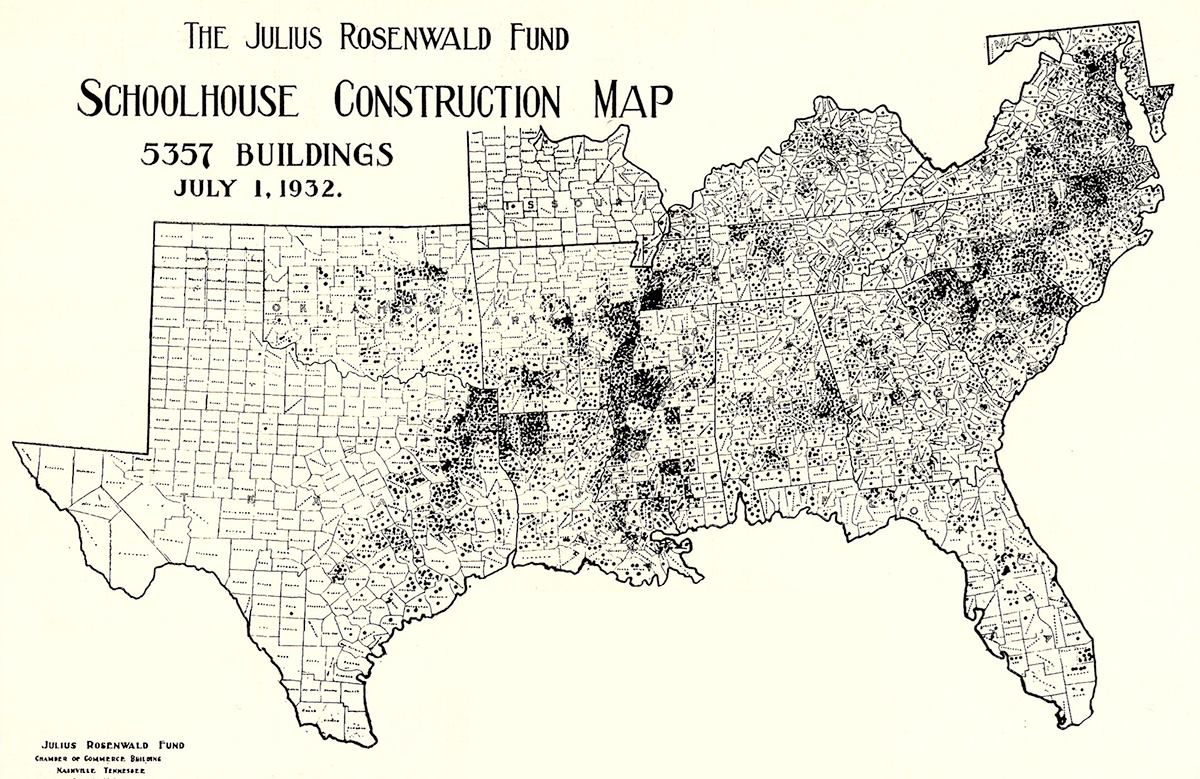
The Rosenwald Fund school building program gave African American communities funding to build and supply schools for Black students between 1913 and 1932. Each dot on the map represents one Rosenwald School. (Fisk University, John Hope and Aurelia E. Franklin Library Special Collection, Julius Rosenwald Fund Archives)
Scores of distinguished alumni attended Rosenwald Schools, including the late civil rights activist U.S. Rep. John Lewis and poet-novelist Maya Angelou. In North Carolina, its leading alumni were Eunice Kathleen Waymon, best known as the singer Nina Simone, and the Rev. Lorenzo Lynch, father of Loretta Lynch, who served as attorney general under President Barack Obama.
School construction ceased after Rosenwald’s death, but the Rosenwald Fund went on to provide educational fellowships to such noted Black artists and scholars as Langston Hughes, Marian Anderson, James Baldwin, Zora Neale Hurston and Ralph Ellison.
The past decade has seen a growing recognition of Rosenwald’s contributions. In addition to Deutsch’s 2011 book about Rosenwald and Washington, there’s a growing body of documentaries. They include Kempner’s “Rosenwald,” and “Under the Kudzu” by Claudia Stack. Two North Carolina-based filmmakers are now producing a set of documentaries they hope will air on local public television stations. The first, “Unlocking the Doors of Opportunity,” tells the story of the 800 Rosenwald Schools in North Carolina. Tom Lassiter and Jere Snyder, the filmmakers, are now completing a documentary on South Carolina’s Rosenwald Schools.
- The two-classroom Russell School was one of 17 Rosenwald Schools built in Durham County, North Carolina, for Black students. It is now owned by Cain’s Chapel Missionary Baptist Church and preserved by the Historic Russell Schoolhouse, a nonprofit. RNS photo by Yonat Shimron
- The two-classroom Russell School was one of 17 Rosenwald Schools built in Durham County, North Carolina, for Black students. It is now owned by Cain’s Chapel Missionary Baptist Church and preserved by the Historic Russell Schoolhouse, a nonprofit. RNS photo by Yonat Shimron
- Phyllis Mack Horton chairs the board of the Historic Russell School in Durham, North Carolina. She stands with her dog, Snowball, outside the school in December 2022. RNS photo by Yonat Shimron
In 2020, Congress directed the National Park Service to conduct a study of the sites associated with Julius Rosenwald. This past year, the service conducted two Zoom hearings and received more than 2,000 comments. It will turn over its study to Congress in 2024.
At a time when relations between some white Jews and Black Americans have become strained — with Black celebrities such as rapper Ye and basketball star Kyrie Irving trafficking in antisemitism — the campaign for a Julius Rosenwald Historic Park is a much needed corrective, said Canter.
“It will add a very positive story in a very negative time about how Americans can work together,” she said, “even if they come from very different backgrounds.”
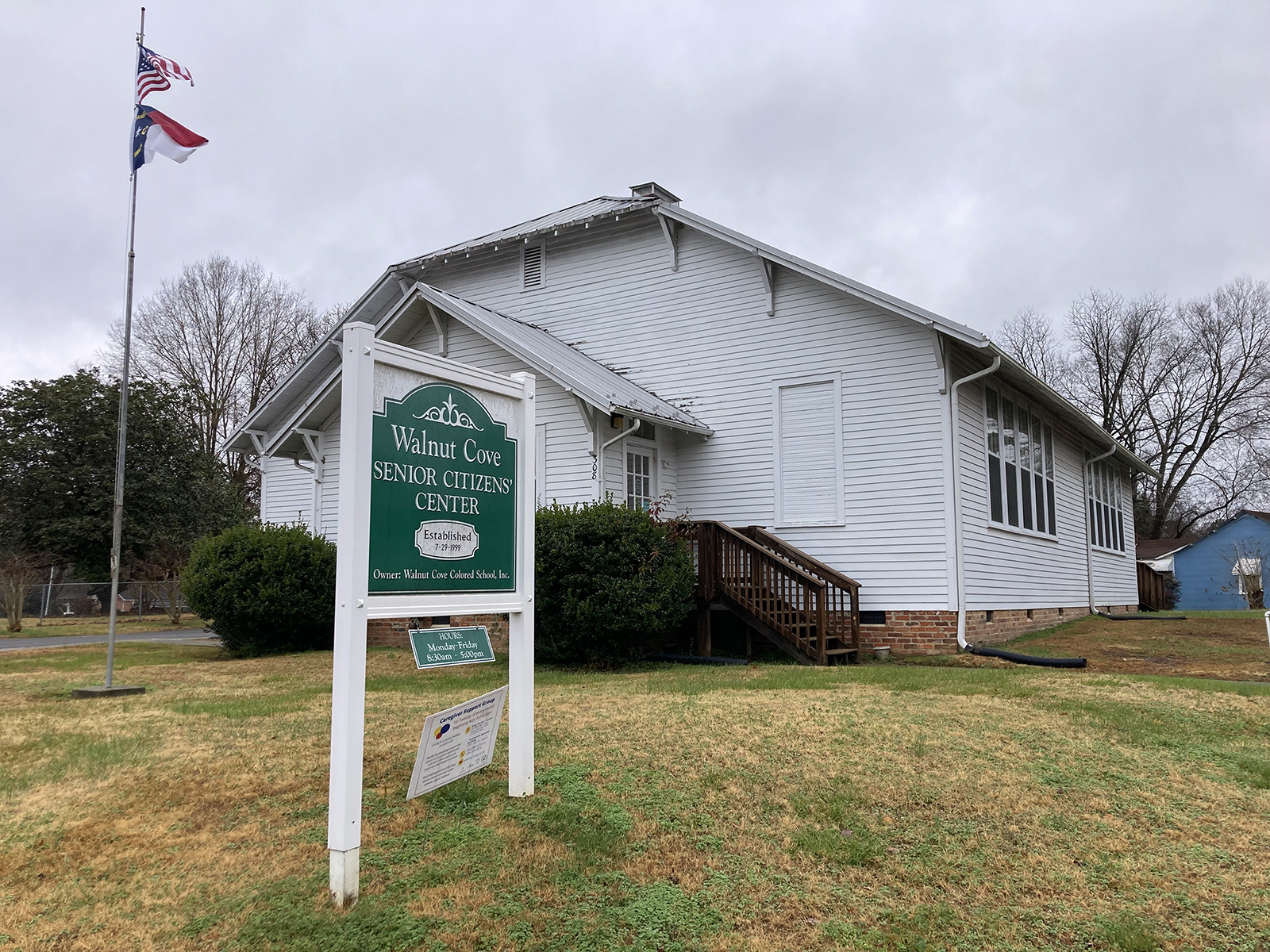
A former Rosenwald School, built in 1921 in Walnut Cove, North Carolina, now serves as a senior center. RNS photo by Yonat Shimron
RELATED: We can’t overlook Kanye West’s antisemitism even if we’re tired of Ye news
